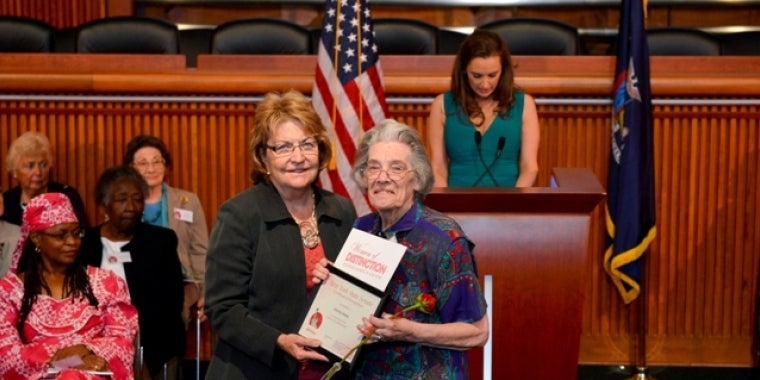
Senate Majority Coalition announces task force on Lyme and other tick-borne diseases
Betty Little
October 9, 2013
-
ISSUE:
- Health

Panel To Develop Recommendations for A State Action Plan To Increase Prevention, Improve Treatment and Diagnosis
Senate Majority Coalition Co-Leaders Dean Skelos and Jeffrey Klein today announced the creation of the Senate Task Force on Lyme and Tick-Borne Diseases to examine state and federal efforts to combat the continued spread of these diseases and make recommendations for a plan to improve prevention, diagnosis and treatment.
The task force will be co-chaired by Senator Kemp Hannon (R-C-I, Garden City), Chairman of the Senate Health Committee, Senator David Carlucci (D, Rockland/Westchester), Senator Kenneth LaValle (R-C-I, Port Jefferson) and Senator Elizabeth Little (R-C-I, Queensbury).
The panel will work on recommendations for a state action plan to address Lyme and other tick-borne diseases modeled after the “2001 West Nile Virus Response Plan.” That plan was developed by the New York State Department of Health in response to the West Nile Virus outbreak in 1999, and New York needs a comparable plan to move the state forward in prevention, diagnosis and treatment of Lyme and other tick-borne diseases.
Senator Hannon said: “While knowledge of Lyme and other tick-borne diseases has been available for many years, far too many people continue to suffer the effects of tick-borne illnesses, demonstrating a need for further action. The consequences of undiagnosed, misdiagnosed, untreated and mistreated infections from ticks can be serious and debilitating. State and federal agencies must work together with local communities and experts in the field to help develop a comprehensive plan to increase prevention and improve diagnosis and treatment in New York.”
Senator Carlucci said: “Sadly, more and more New Yorkers are falling ill to Lyme disease each year. This bipartisan task force is a meaningful first step towards reversing this trend and finally addressing the serious dangers posed by Lyme disease and other tick-borne illnesses. By working collaboratively and listening to some of the top research experts in the field, I'm confident we can implement a serious plan that promotes prevention, increases education and awareness, and ultimately improves the quality of life for those who remain at risk."
Senator LaValle said: “I have, for many years, worked with the East End towns in my district to seek ways to control ticks and the spread of tick borne diseases, including securing funds for four-poster feeding stations. Tick-borne diseases and, specifically, Lyme disease are debilitating and must be controlled and stopped. I thank Senator Skelos for appointing me to this task force and look forward to getting to work on this issue.”
Senator Little said: “Many of us know at least one person who has had a Lyme infection. As the incidence of infection grows, it’s abundantly clear that this very serious health issue needs more attention. There are so many questions about diagnosis and treatment. Ultimately, the goal is an effective vaccine that will prevent infection altogether but, in the meantime, much more needs to be done to ensure that patients get the treatment they need to avoid what can become a lifelong ailment.”
The Centers for Disease Control recently estimated that about 300,000 individuals are diagnosed with Lyme each year nationally. Lyme is the most commonly reported of all tick-borne illness in the United States. There are 13 states that account for almost all of those cases; many of the cases are in New York.
There are also fears that Lyme disease may, in fact, have broader consequences than the symptoms we generally associate with the illness. According to recent news analysis of state Health Department records, over the past 13 years, Lyme disease was listed as the cause of deaths for nine New Yorkers, outside of New York City. Five of the victims lived in the mid-Hudson Valley. Given the number of cases and severe effects that Lyme and other tick-borne diseases can cause, New York must take action.
Other members of the Senate Task Force on Lyme and Tick-borne Diseases include: Senator Mark Grisanti (R, North Buffalo), Senator Kathleen Marchione (R-C, Halfmoon), Senator Greg Ball (R-C-I, Patterson), and Senator Bill Larkin (R-C, Cornwall-on-Hudson).
Senator Grisanti said: "As Chairman of the Environmental Conservation Committee, it is important to for all agencies to work together to raise awareness and at all costs attempt to prevent this terrible disease."
Senator Kathleen A. Marchione (R-C, Halfmoon) said: “Confirmed cases of Lyme disease are on the rise in our state, and that alarming fact should concern every New Yorker. It’s absolutely critical that we take pro-active steps to provide more resources to combat this disease and, most importantly, help provide care, comfort and compassion to those affected by it. I recognized the growing concern of Lyme disease early on and selected Dr. Kari Bovenzi, one of New York’s foremost experts on treating and combating Lyme disease, especially among children, as my 2013 Senate ‘Woman of Distinction.’ I am honored to be part of this bi-partisan task force and look forward to working with my colleagues to find real solutions and responsive public policies to better identify, prevent and treat Lyme disease.”
Senator Ball said: “The Hudson Valley has an extremely high concentration of Lyme and tick related diseases. It is vital that we work together as lawmakers to improve treatment and ultimately towards preventing these life-changing diseases. I am honored to serve on this task force and I look forward to working closely with my colleagues to develop innovate ways to combat these diseases."
Senator Larkin said: “I want to thank Senate Majority Co-Leaders Skelos and Klein for recognizing the importance of Lyme and tick-borne diseases and making their prevention and treatment a priority for the Senate. With the extreme prevalence of Lyme and other tick-borne illnesses in the Hudson Valley, I am looking forward to making sure that the needs of our friends, neighbors, and family members who suffer from these debilitating diseases are addressed.”
The task force will explore innovative ways of addressing tick densities, such as the “Four- poster” deer tick program that uses deer feeding stations designed in such a way that the animal must put its neck, where most of the ticks congregate, through two gentle rollers that contain an insecticide to kills ticks. Studies of the four-poster system, including one by Cornell, have shown a remarkable reduction in the tick population.
The Task Force will review research, consult with experts, hear from the public and work with the appropriate State and Federal agencies in developing recommendations for a New York State Action Plan on Lyme and tick-borne diseases which can serve as a comprehensive roadmap for the state to improve diagnosis and treatment to prevent future tragedies.
####
Share this Article or Press Release
Newsroom
Go to NewsroomJohn Webster
May 16, 2014

Shirley W. Seney
May 14, 2014


